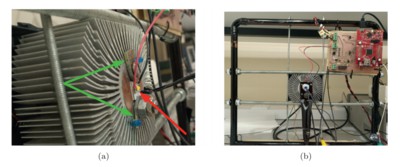Despite being efficient devices, when compared to other light sources, the high-power light emitting diodes (LEDs) suffer from heating effects that hurt their reliability. Power LEDs are typically assembled on metalcore printed circuit boards (MCPCBs) to facilitate the extraction of heat. Diamond wafers can also be used for the same purpose since diamond is the best isotropic conductor of heat known to man and simultaneously an electrical insulator. To evaluate the impact of the boards on the device lifetime, high-power Cree LEDs were mounted on FR4, MCPCB, and diamond boards. The case temperature was measured for different current ratings, and the aging acceleration factor of the devices mounted on FR4 and diamond wafers was estimated relative to the LEDs mounted on the MCPCB boards. Diamond wafers were shown to have a tremendous impact on the lifetime; for the nominal current level, and depending on the activation energy of the aging processes, the LEDs mounted on diamond boards age 60–80 % slower than their counterparts mounted on the MCPCB boards.
High power light emitting diodes (LEDs) have become the main light source in everyday applications. These compact devices have a large lighting capability and spend only a fraction of the energy required to power filament bulbs, nevertheless, self-heating is one of the most limiting issues of power LEDs. Although lighting LEDs do not emit IR radiation directly, at high levels of current, the non-radiative recombination processes and the parasitic ohmic losses in the contacts and cladding layers cannot be neglected and it is estimated that 75 % of the electric power is converted into heat.
The LED die is typically encapsulated inside a dome-shaped material with a large refractive index. This dome improves the extraction of light from the device; however, some materials are also poor conductors of heat, which creates an additional issue since convection may no longer be used to remove the heat away from the junction. Both LED manufacturers and circuit designers have come up with a variety of creative strategies to carry the heat away from the junction and guarantee that the junction temperature TJ remains as low as possible during device operation.
At the system level, the temperature may be controlled with a thermoelectric cooler. These devices can be used together with fans or thermoelectric generators, allowing the thermal energy dissipated by the LED to be partially recycled. Heat sinks (HS) are another possibility; for example, the impact of using graphene-coated and honeycomb HSs have been evaluated numerically. An HS with integrated heat pipes has also been proposed and verified experimentally.
At the circuit level, the use of power boards should be taken into
consideration. Ceramic boards as well as metal core printed circuit boards (MCPCBs) are two of the options available to the circuit designer. They can be complemented with thermal microvias or heat pipes. Huang used polymer-filled composites to further enhance radiative heat transfer from the board. Different approaches have also been proposed to minimize package thermal resistance.
The efficiency of a power package was increased by 3 % by including a copper (Cu) heat spreader. When attaching the LED die to the carrier, replacing wire bonding with a flip chip improves the extraction of heat from the LED die, especially if combined with sub-mounts with large thermal conductivity (λ). Different sub-mount materials have been proposed, such as alumina (Al2O3), silicon (Si), aluminum nitride (AlN), and diamond wafer. The LED die has been further integrated with a Si TEC MEMS using a flip-chip and the impact of the solder pads, solder bumps, die to attach, and underfills has also been evaluated. Thanks to properties such as high band gap (5.4 eV), breakdown electric field (2 × 107 V/cm), and λ (1800–2000 W/(m⋅K)), diamond comes as a candidate to improve the thermal management of power devices. The use of diamond as an HS has been proposed in 1967; in comparison with regular Cu HSs, its use doubled the continuous power density of Si avalanche diodes. Diamond has also been used to improve the thermal management of power LEDs at different levels. Horng et al. mounted the LED die on an aluminum (Al) board coated with diamond wafer and obtained an 11 ◦C reduction in TJ at 350 mA in comparison to mounting the LED on a conventional MCPCB. Chen et al. reported a 20 ◦C reduction in TJ at 1 A when the LED chips were bonded to Si substrates coated with 20 μm of a diamond. Fan et al. replaced the Cu HS of white power LEDs with a diamond/Cu composite material and the weight of the internal HS was reduced by more than 35 %; simultaneously the thermal resistance and TJ decreased by 10.5 % and 33.3 %, respectively. Diamond films have also been integrated into grooves etched on the upper ITO layer of LEDs. The replacement of the AlN carrier of Cree XLamp XB-D LEDs with a diamond wafer is estimated to improve the lifetime of the devices by 25 % and 50 % for 350 (nominal current) and 800 mA, respectively, and to decrease the drift of the wavelength with the current level.

CSMH is a joint venture company based on cutting-edge semiconductor manufacturing technologies with investments from Korea, China, and Singapore. We are equipped with advanced semiconductor production equipment to produce high-quality diamond wafer, diamond heat sinks and AlN templates on a variety of substrates, including AlN on Sapphire, AlN on Diamond, and AlN on Si. Our product's performance has improved to a level that is among the best in the world.
 闽ICP备2021005558号-1
闽ICP备2021005558号-1Leave A Message